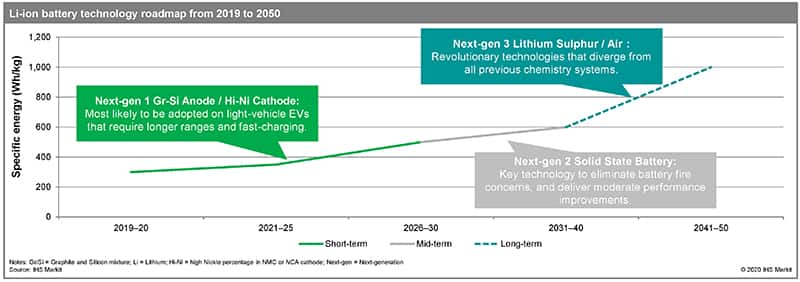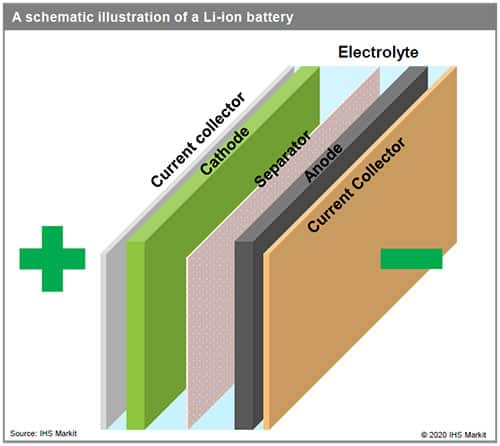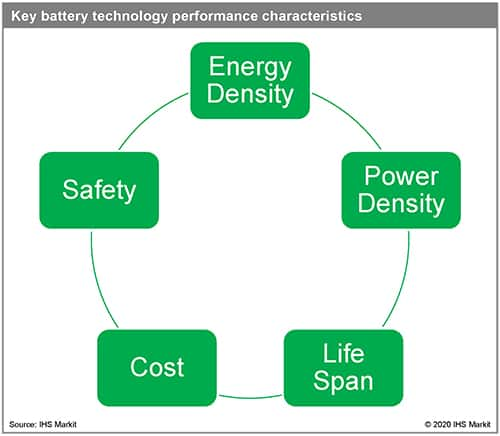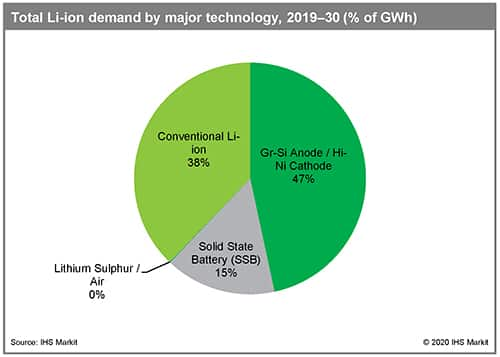Customer Logins
Obtain the data you need to make the most informed decisions by accessing our extensive portfolio of information, analytics, and expertise. Sign in to the product or service center of your choice.
Customer LoginsNew Battery Technology for the Future
Explore the future of battery technology
Lithium-ion batteries dominate today’s rechargeable battery industry. Demand is growing quickly as they are adopted in electric vehicles and grid energy storage applications. However, a wave of new improvements to today’s conventional battery technologies are on the horizon and will eventually be adopted in most major end markets.
New battery technology breakthrough is happening rapidly. Advanced new batteries are currently being developed, with some already on the market. The latest generation of grid scale storage batteries have a higher capacity, a higher efficiency, and are longer-lasting.

Specific energy densities to gradually improve as new battery technologies become ready for mass deployment.
Click to enlarge
Latest developments in new battery technology provides a range of improvements over conventional battery technologies, such as:
- Improved specific energy and energy density (more energy stored per volume/weight)
- Longer lifetime
- Better safety / less flammable
- Require less time to be fully charged
- Reduced levelized cost of energy (LCOE)
Before we delve into the current and upcoming battery technologies, let’s first look at the anatomy of batteries. The table below lists out the key parts of a battery and its functions:
| Battery components | Typical composition | Function |
|---|---|---|
| Cathode | Lithium, Nickel, Cobalt, Manganese, Aluminum, Iron, and Phosphate | Contributing Li-ions through the channel of electrolyte and electrons to be stored at anode side |
| Anode | Graphite, Silicon (Si) | Keeping Li-ions stored when battery is charged and releasing Li-ions and electrons back to cathode when discharged |
| Separator | Polyethylene (PE) | Keeping cathode and anode materials separated while allowing Li-ions capable of travelling between them |
| Current collector (Cathode) | Aluminum (Al) | Collecting electrons generated from the electrochemical reaction at the cathode side while preventing it from being oxidized by cathode materials |
| Current collector (Anode) | Copper (Cu) | Collecting electrons generated from the reaction at the anode side while preventing it from being oxidized by anode materials |
| Electrolyte | Solvents (EC, DMC, DEC, EMC, PC, and etc.); Salts (LiPF6, LiClO4, LiBF4, and etc.) | Providing Li-ions with a good conductivity while maintaining a good thermal stability and a wide operable voltage window |
The lithium-ion battery diagram below illustrates how the individual components of lithium battery cells are arranged.

Lithium-ion battery anatomy
The future of lithium-ion battery technology is based on three specific technological advancements.
Improvements in new battery technology can be achieved in a huge range of different ways and focus on several different components to deliver certain performance characteristics of the battery. While there are various paths that battery technology evolution could take, S&P Global has defined three new alternatives to lithium-ion batteries in the table below.
| Overview of next-generation battery technologies | |||
|---|---|---|---|
| Current Conventional Li-ion | Next-generation 1 Gr-Si Anode / Hi-Ni Cathode: | Next-generation 2 Solid State Battery (SSB) | Next-generation 3 Lithium Sulphur / Air |
Most favorable technologies for today's EV and stationary energy storage applications
| Most likely to be adopted on light vehicle EVs that require longer ranges and fast charging.
| Key technology to eliminate battery fire concerns and deliver moderate performance improvements.
| Revolutionary technologies that diverge from all previous chemistry systems.
|
Five key performance characteristics of battery technology evolution

Key battery technology performance characteristics
Energy Density
Energy density is also known as volumetric energy density (Wh/L) or gravimetric energy density, which is defined as specific/gravimetric energy (Wh/kg) in technical terms. These two values are associated directly to the amount of energy that can be stored per unit volume or mass. The weight and size of batteries are of critical importance to adoption in EV and stationary energy storage applications.
Power Density
Battery power density is the amount of energy released by a battery when it is discharged within a given capacity. Specific power, like specific energy, refers to the amount of energy produced per unit of mass.
Charging rate
Charging rate is a term used to describe the amount of power required to charge a device (C-rate). The discharge power of a battery measures how much energy it can produce at any given moment, while the C-rate embodies how fast a battery can be fully charged.
Life Span
A battery's capacity decays with the amount of charge and discharge cycles, showing how long it will last. A battery should be reused (second life applications) or recycled once it has degraded to a point when it is no longer suitable for its intended application.
Cost
The cost of battery is usually defined on a per kWh basis and is the key focus in achieving EV cost parity with internal combustion engine (ICE) vehicles as a battery pack system is the most expensive single component of an electric vehicle (EV).
Safety
Because of the flammable liquid electrolyte and the release of thermal energy when the cathode material ‘fatigues' after a certain number of cycles, battery safety is a concern. The rising concerns over battery safety could inhibit the wide adoption of EVs and batteries for energy storage applications.
Key battery parameters: Energy density and specific energy
The amount of electrical energy contained in a battery cell per unit mass (specific energy) and unit volume (energy density). The current value is calculated by multiplying the extractable cell power (Ah) by the discharging voltages (V) separated by the mass (kg) or volume (L). It is also referred to as gravimetric (specific energy) or volumetric density (energy density). Major factors that determine the value are cell (or module and pack) design, current density, and operable voltage range.
One of the most important metrics for the adoption of batteries in the transportation sector is energy density. It is the determining factor for major issues such as electric vehicle (EV) range, battery safety as well as EV versus internal combustion engine (ICE) cost parity. With continued improvements in this area, the adoption of EVs is becoming more realistic than ever.
New battery technology impacts and trends
Aspects that impact parameter:
- Choice of cathode materials significantly affects the specific energy at full cell level. For example, a battery using an LFP cathode is of lower energy density than that using NMC.
- Anode material, typically graphite, provides a room for lithium ions to stay when the battery is charged. The number of Lithium ions stored directly links to how much electrical energy is stored.
- Fast charging requires higher charging current density, which leads to fully charged capacity (Ah) lower than stated.
- The weight of the cell/ module/pack directly links to energy density. The amount of weight of materials should be minimized.
Technical challenges:
- Lithium-ion battery cells are much more inclined to catch fire as lithium-ion battery energy density continues to be improved.
- As the EV penetration rate rises, the efficiency of the charging network requires faster charging infrastructure. However, fast-charging a high energy-density battery is more likely to cause safety issues.
- Anode materials must match up the cathode with the same amount of Lithium-ion capacity. Graphite is becoming the limiting factor to the rising capacity of cathode materials.
Battery technology trends to improve parameter:
- Cathode technology is transitioning from a typical Ni percentage of 50%, towards 80% and 90%, respectively, for NMC and NCA batteries.
- In order to match up the capacity provided by hi-Ni percentage cathodes, adding a minor amount of Silicon oxides or pure Silicon into graphite anodes is growing in favor by cell manufacturers.
- Battery cells are increasing in size so that more energy can be stored in one cell with less casing materials used, which leads to reduced weight. (this also applies to the transition towards larger battery module sets)

New battery technologies pose to overtake conventional Li-ion in the next decade

98% of next generation end-market battery demand comes from the automotive and transport sector.
Future Trends and Implications for Battery Technology
S&P Global projects that the readiness of each future battery technology is dependent on how much the technology deviates from the existing Li-ion battery technologies. As electric cars continue to dominate the Li-ion demand, the performance of new battery technologies face a strong influence from the design requirements of light full-electric vehicles. Low flammability, faster charging with moderately higher energy density tends to be the focus of next decade.
Read our review of alternative energy storage technology and learn more about the composition of new battery technologies and their key components.
Batteries challenge gas peakers for California’s capacity needs
Get first-hand experience on our Climate and Sustainability DEMO HUB
Keep up-to-date with latest climate and sustainability news.
Sign-up to receive our free newsletter today! Available daily or weekly.
{}
{"items" : [
{"name":"share","enabled":true,"desc":"<strong>Share</strong>","mobdesc":"Share","options":[ {"name":"facebook","url":"https://www.facebook.com/sharer.php?u=http%3a%2f%2fwww.spglobal.com%2fesg%2fs1%2ftopic%2fthe-future-of-battery-technology.html","enabled":true},{"name":"twitter","url":"https://twitter.com/intent/tweet?url=http%3a%2f%2fwww.spglobal.com%2fesg%2fs1%2ftopic%2fthe-future-of-battery-technology.html&text=New+Battery+Technology+for+the+Future+%7c+S%26P+Global","enabled":true},{"name":"linkedin","url":"https://www.linkedin.com/sharing/share-offsite/?url=http%3a%2f%2fwww.spglobal.com%2fesg%2fs1%2ftopic%2fthe-future-of-battery-technology.html","enabled":true},{"name":"email","url":"?subject=New Battery Technology for the Future | S&P Global&body=http%3a%2f%2fwww.spglobal.com%2fesg%2fs1%2ftopic%2fthe-future-of-battery-technology.html","enabled":true},{"name":"whatsapp","url":"https://api.whatsapp.com/send?text=New+Battery+Technology+for+the+Future+%7c+S%26P+Global http%3a%2f%2fwww.spglobal.com%2fesg%2fs1%2ftopic%2fthe-future-of-battery-technology.html","enabled":true}]}, {"name":"rtt","enabled":true,"mobdesc":"Top"}
]}



